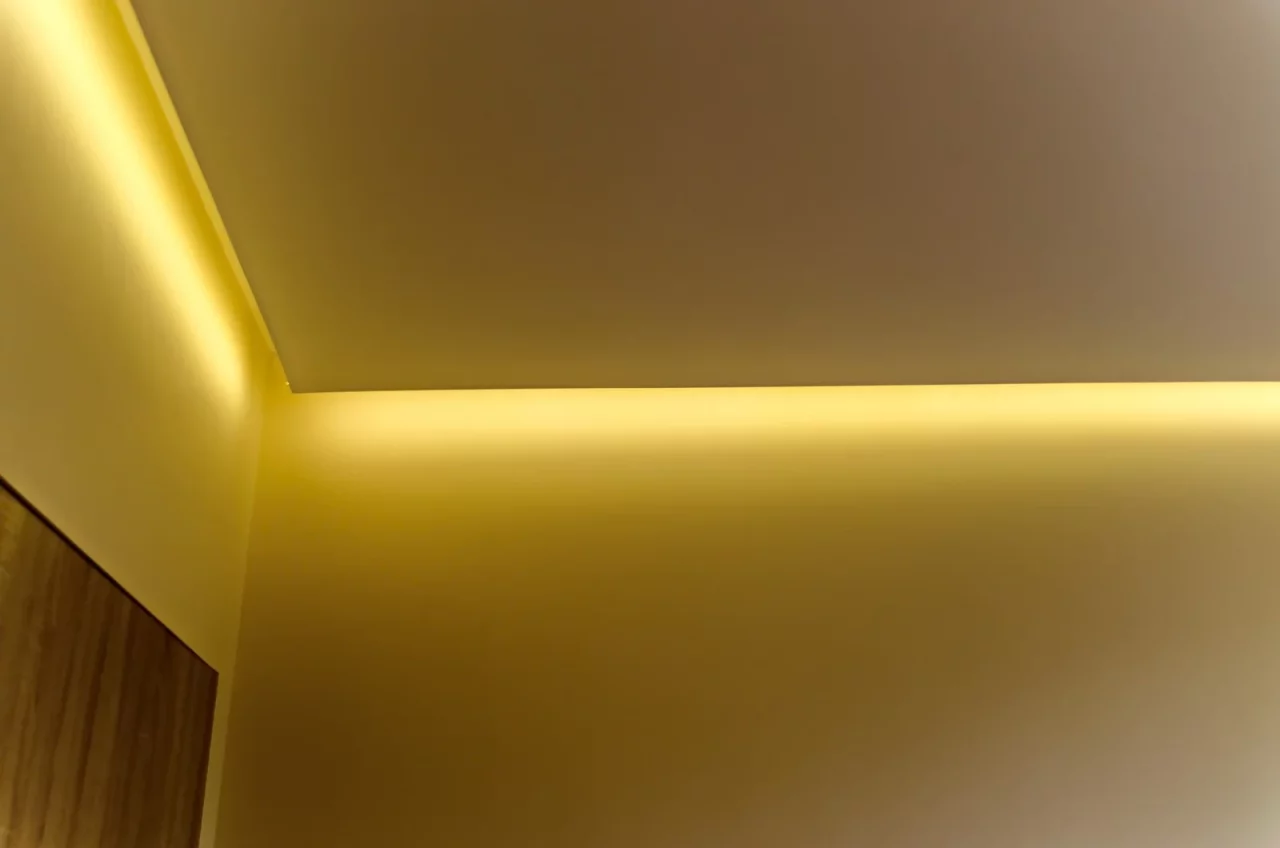Essential Tips for Ceiling Light Design in Your Home
Crafting the ideal ambiance in your home goes beyond furniture and paint colors. Ceiling lights play a crucial role in shaping the atmosphere and functionality of each space. This guide equips you with essential tips and insights for interior ceiling lighting design – helping you create a haven that reflects your style and caters to your needs.
Ceiling Light Design & Your Home's Aesthetic and Functionality
Ceiling lights provide basic illumination for our homes. However, carefully chosen fixtures and thoughtful placement can elevate the aesthetics of a space, set the mood, and enhance functionality. By understanding the different types of ceiling lights, their placement, and the various lighting techniques available, homeowners can transform their living spaces into harmonious and visually captivating environments.
How the Right Ceiling Light Design Can Transform Any Space
From enhancing architectural features to creating a cozy atmosphere, the right ceiling light design plays a crucial role in setting the mood and highlighting key elements within a room. Carefully selected ceiling lights can add depth, warmth, and character to any space. Whether you prefer sleek modern fixtures or elegant traditional designs, the right lighting choice can elevate the aesthetics of your space while also improving its functionality.

What Exactly is Ceiling Light Design?
Types of Fixtures
You can select chandeliers, pendants, flush mounts, recessed lights, track lighting, sconces, and more. Each type offers unique advantages that complement the overall design theme of the room, whether modern, minimalist, traditional, or rustic. Additionally, consider materials like glass, metal, fabric, or wood, and finishes like chrome, brushed nickel, or bronze to add visual and texture interest.
Lighting Techniques
- Dimming: Adjustable light levels create different moods and cater to various activities.
- Color Temperature: Warm, cool, or tunable white bulbs set the desired ambiance and complement the room’s color scheme.
- Task Lighting: Illuminates specific areas for focused tasks.
Ceiling lights play a crucial role in shaping the ambiance and overall aesthetic of a space. They set the mood and influence how we perceive and interact with a room. Carefully chosen fixtures and thoughtful placement can create a warm and inviting atmosphere in a living room, a focused and productive environment in a workspace, or a calming and serene retreat in a bedroom. By manipulating light levels, color temperature, and layering techniques, ceiling lights can evoke a spectrum of emotions from energizing vibrancy to cozy intimacy. Ultimately, they become integral design elements, weaving their magic into our homes and shaping the experiences we create within them.
Types of Ceiling Light Fixtures
Chandeliers
Serve as the grandeur and elegant focal point of a room with their multi-branched fixtures. They create a dramatic statement in entryways, dining rooms, and high-ceilinged living areas.
Pendant Lights
Hang from the ceiling on a single cord or chain, providing focused illumination. They highlight specific areas like kitchen islands, breakfast bars, or task areas in a workspace.
Recessed Lighting
Seamlessly integrated into the ceiling, offers a minimalist look and provides general and diffused illumination throughout a room. They are ideal for low ceilings or creating a clean, modern aesthetic.
Flush Mounts and Semi-flush Mounts
Sit close to the ceiling, making them suitable for rooms with lower ceilings or where headroom is limited. Flush mounts sit directly against the ceiling, while semi-flush mounts hang slightly below.
Track Lighting
Features spotlights mounted on a track that can be adjusted and repositioned to direct light exactly where it is needed. It’s ideal for accentuating artwork, creating focused task lighting, and showcasing specific areas of a room.
Tips on Planning Your Ceiling Light Design
Consider the following factors:
Room Size and Ceiling Height
- Standard ceiling heights (8-10 feet): Consider flush or semi-flush mount fixtures to provide adequate illumination without overwhelming the space.
- High ceilings (10 feet or higher): Accommodate hanging pendants or chandeliers to add visual interest and drama to the room.
Lighting Layers
- Ambient Lighting: Consider recessed lights, flush mounts, or track lighting to light the space evenly.
- Task Lighting: Install specific fixtures to illuminate areas for specific tasks.
- Accent Lighting: Use wall sconces or picture lights to highlight artwork, architectural features, or decorative elements in the room.
Color Temperature and Brightness
- Color Temperature: Warmer temperatures (2700K to 3000K) create a cozy ambiance for living areas, while cooler temperatures (3500K to 4000K) are better suited for task-oriented spaces.
- Brightness: Dimmer switches provide flexibility to adjust the lighting based on the time of day and specific activities.
Designer Ceiling Lights as Artwork
Designer ceiling lights transcend their purely functional purpose, transforming into captivating works of art that elevate the style of your home. Here’s how:
Sculptural Masterpieces
Boast unique shapes and intricate details, acting as sculptural elements that captivate the eye. These fixtures become focal points, adding artistic flair to any space.
Material Magic
Gleaming metals, sparkling crystals, hand-blown glass, and woven fabrics add textural and visual appeal.
Combination of Light and Shadow
Chandeliers with cascading crystals create mesmerizing patterns of light and shadow, while strategically placed sconces can bathe walls in a warm glow, adding dimension to the space.
Design Language
Choosing fixtures that resonate with your overall design aesthetic creates a cohesive and visually appealing environment. They become integral parts of the design narrative, tying the space together.
Investment Pieces
High-quality designer lighting fixtures are often considered investment pieces, adding value and lasting style to your home.

Tips on Selecting Designer Lights
Here are some tips to help you choose the right lighting that aligns with your design theme:
1. Understand Your Design Theme
Understand the overall design theme of your space. Whether it is modern, traditional, industrial, or minimalist, the lighting should reflect and enhance the theme.
2. Consider the Color Scheme and Materials
Take into account the color scheme and materials used in your interior design. For example, if your space features predominantly natural materials, consider lighting fixtures with similar textures to create a cohesive look.
3. Size and Scale Matter
Pay attention to the size and scale of the lighting fixtures in relation to the room. A large fixture might overwhelm a small dining area, while a tiny one may get lost in a spacious foyer.
4. Functionality vs. Aesthetics
Consider the specific lighting needs of each area while also choosing fixtures that contribute to the overall visual appeal of the space.
5. Create a Cohesive Look with Layering
Use different lighting sources (ambient, task, or accent lighting) to create layers of light that work together harmoniously.
Common Pitfalls in Ceiling Light Design
- Over Lighting – An abundance of bright light can create a sterile and uncomfortable atmosphere. Resist the urge to rely solely on a single and powerful overhead fixture.
- Poor Placement – Improper placement can lead to unwanted glare or leave areas underlit, creating an uneven and visually unappealing effect. Consider the purpose of each space and position lights strategically to achieve balanced illumination.
- Neglecting Dimmer Switches – Without dimmers, you lose the ability to adjust the mood and cater to different activities. This inflexibility can leave your space feeling overly bright or inadequately lit depending on the occasion.
Ceiling Lights and You
From selecting the right fixture type and placement to embracing the power of layering and dimming, interior ceiling lighting design can be a rewarding journey. Remember to consider the size and purpose of each space, prioritize balanced illumination, and leverage the versatility of different lighting techniques. Feel free to experiment with various color temperatures and explore the artistic potential of designer fixtures. Embrace the power of light to transform your home, and find the perfect combination that fosters functionality, reflects your unique style, and creates an ambiance that speaks to your soul. Unleash your creativity, and enhance beauty, and functionality in every room.
